By night and by day, invisible hands are laying claim to the walls of New York City. They work quickly and are gone before anyone notices. What they leave behind is art, if not, a message. The prints, stencils, stickers, and other objects await discovery by a passing pedestrian—perhaps a woman walking a dog, perhaps a sales clerk on his way to night school—but unlike nearly everything else that decorates our public space, these communications are not hawking the latest shoes or the newest low-carb beer. Street art is many things. It is a resistance against the notion that only paid-for corporate advertising can take hold in our visual commons; the monopoly is to be broken. Street art appears underneath and along side of sanctioned billboards, sometimes replacing them. Other times, it appears on bare walls far from most people’s gaze. It is public playfulness. It is a gift, a knowing nod, to those who notice.
Street art is frequently confused with graffiti, but street artists often use formal art techniques—printmaking, silk-screening, even sculpting—in contrast to the immediate, almost painterly methods of spray-can-wielding graffiti artists. In this way, street art has survived and proliferated in the face of police crackdowns. It has adopted the propagative mechanisms of print and advertising culture to remain elusive, widespread, and relevant, all at the same time.
More than just surviving, the movement has entered global popular culture. More and more people now participate in street art, not just in New York, but in places like London, Berlin, Tokyo, and Rio de Janeiro. There are magazines and art galleries devoted to street art. Even some large corporations have noticed and are looking at using street art as a way to reach young and design-conscious consumers.
This roundtable interview gathers a few of the people involved in the scene to talk more about the past, present, and future of street art.
The Contributors
Michael De Feo, also known as the Flower Guy, recently published a children’s book, Alphabet City. (medefeo.com, alphabetcitybook.com)
Patrick is part of the well-known street-art and design group Faile. (faile.net)
Swoon’s cutout and block prints have appeared on walls all over New York City, among many other places all around the world. (TMN profile)
Dan Witz has been making street art in New York City since the 1970s. (danwitzstreetart.com)
Wooster Collective, run by Marc and Sarah, spotlights street art around the world. (woostercollective.com)
In the touchstone book Taking the Train, Joe Austin described how in the booming years of graffiti, the word “street” had become associated with urban crisis: crime, poverty, and disorder. What does the word “street” in street art mean to you right now?
Swoon: It’s my impression that the word “street” came to mean urban crisis at a time when new highways were being paved leading directly to the suburbs. People with any means were busy figuring out how to isolate themselves in their cars and gated communities. In some ways this is still going on. Sprawl is still eating up the American landscape, but I think there is a kind of awakening going on about the need for dense public spaces. There lies the sentiment behind the newly reborn popularity of the word. To me, the word “street” means the river of cleverly organized chaos in which I am always trying to ride my bike. It is the common space that connects everyone to everyone else in one way or another.
Michael De Feo: I look at the “street” in the same way I look at New York City: a never-ending source of excitement and inspiration. By contributing to the street, in my own small way, I contribute to New York.
Dan Witz: Street art for me has always meant freedom from the artist’s game—galleries, the career machine, all that frustrating, soul-sucking, dissatisfying bullshit. Going out on a street mission is my unsupervised playtime—no responsibility, no expectations, no need to worry about the artwork’s life outside that moment.
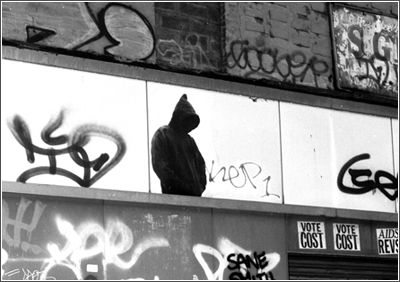
Nothing against the art world—I happen to love art museums and galleries, and that’s how I’m lucky enough to make my living—but that kind of art is protected, isolated from real life (which is part of why I like it). I think I use the street-art side of my work to balance myself out, to keep me awake, and exposed, and uncomfortable.
Patrick of Faile: “Street art” is a term that helps to define everything in terms of the art in our urban landscape outside of what is otherwise known as graffiti. The term itself I have come to find very annoying over time through overuse, something like way the word “dude” can be used by someone over and over again. I feel as if the term has been used so much that it has become watered down, and in a way, so has street art itself. If I had to give a proper definition of the term, it would sound like Dan Witz’s definition.
Wooster Collective: When most people first hear the words “street art,” they immediately think of urban settings and industrial locations. But some of the most interesting and exciting street art is being done in the most unlikely of places and far from city centers. We consider Andy Goldsworthy a “street artist,” yet his work is almost never found on the street and is most often placed in extremely remote and rural settings. Before the internet, to be included a community of street or graffiti artists you had to place your art next to others.’ And the cities became the galleries. The major cities became places for graffiti artists to share their work and become known. But with the internet, an artist can put work up anywhere in the world and then through a website or a photo log, with a digital camera, they can share their work with others around the world.
Street art is about using your environment as a collaborator. City streets can be incredibly vibrant canvases for artists to work with. But more and more, artists are discovering that other settings can be equally exciting. If you look around you will see street art in the countryside, on the beach, in the mountains.
The Wooster Collective bring up a good point about the availability of information in street-art circles, especially in light of the internet. What have been some effects of this connectivity, considering cultural, political, and economic differences around the world? Is there also a negative side effect? What has your international experience been like?
Patrick of Faile: The internet has made making a living from this type of art much easier, because it allows artists to expose their work to a much wider audience. The widened distribution has, in turn, helped us to diversify our business, in a way. When things slow in one market or city, we can work in others, helping us not to overexpose our work in one particular city. Through the internet we have been invited to do shows in cities around the world. Not only is it great to be able to bring your work to other cities, but it’s also great to be exposed to new cultures and fresh new ideas, which I think is invaluable to an artist. We have become so inspired by all the countries we have visited. It’s important to get out of the U.S. and see things firsthand and not just on the TV. You cannot grow as an artist sitting on your couch. We have grown as artists, have met friends we love, and have been able to keep Faile moving on so many other levels other than just on the New York end. I would have to say that Faile has been financially supported mostly through the foreign contacts we have made along the way. When you are bringing art to people around the world with good intentions, politics seem to take a back seat. People open up to you and things happen that you could never imagine.
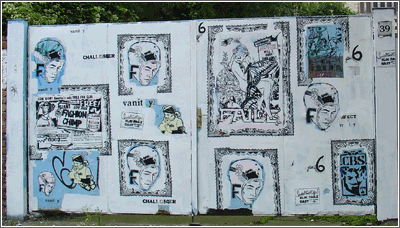
M. De Feo: The internet allows the casual observer and the people that regularly follow street art to look at work that is otherwise inaccessible. Sites like Wooster Collective are invaluable. How else can you traverse the globe in a few minutes from the comfort of your own home to see brand new work in the streets? It really is incredible.
There’s an interesting contradiction to experiencing street art on the internet, and in books and magazines. Although, as media, they bring our work closer to an audience, they also distance the audience from the street art as well. The experience of being on the street and having the work engage you in a very personal way is an important element to taking in street art. Works on the street are not curated. You don’t know what’s coming and where it is going to be. The element of surprise is a wonderful part of encountering street art. That doesn’t really exist when you’re online.
That being said, the internet has enabled me to travel and meet people from around the world. Street artists seem to have this amazing hospitality allowing each other to crash on their sofas whenever they’re in town. I agree with Patrick that through good intentions, amazing things happen. There are so many different people in so many different places that share our passion… it’s awesome.

Swoon: I can be fairly antiquated in my lifestyle and work methods, so it never would have occurred to me to have a website or even an email address attached to my work, but my good friend who started up a design and music collective called Change Agent made a page for me and insisted that I maintain my contact information on the site. It seemed funny at first, but through that contact info I began receiving thank-you mails from people whose buildings I had just decorated. Shortly thereafter, I helped students in Sweden write their dissertations, and there seemed to be something intrinsically right about this. I work on the street for a number of reasons, one of which is the desire to communicate with people. For me, the internet has represented a sort of barometer of the success of that communication. I’ve received so many stories about my work that I would have no way of hearing otherwise, and I appreciate the way the internet allows us to broaden our communication in its funny, isolating, trapped-behind-a-computer-screen kind of way.
Dan Witz: I’ve made lots of international contacts through my website. There’s no question that the internet is why street art’s the huge rockin’ scene it is today. And full credit goes to the Wooster Collective for doing a tireless and magnificent job of shepherding us all along. They light a fire daily.
Street art and graffiti has its roots in rebellion; it’s a medium for the disenfranchised. By nature it threatens the status quo. With the advent of the internet and cheap digital sampling technology, and with parallel developments in music and skater/low-brow culture, and then, with George Bush ramming his fascist agenda down the world’s throats…street artists are speaking up. Or so it seems. If you believe what you see on the internet…
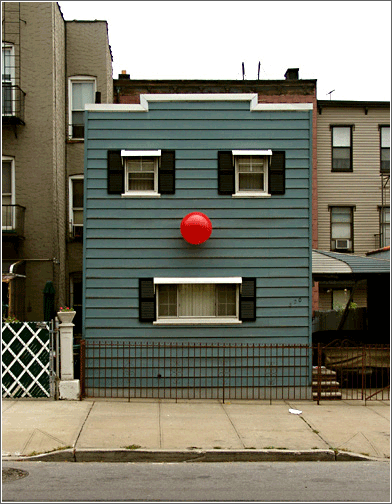
Anyway, God bless the internet. It may be our only hope.
The negative side effect of all this is that now that street art is so in fashion, I gotta say (sorry, folks), it’s inevitably got to go out of fashion.
Wooster Collective: Like most things, the internet has both positive and negative effects. But for us, the positive effects clearly outweigh the negative.
The most positive effect is that the internet allows the movement to be completely inclusive on a global level. The current street-art movement is a global phenomenon that is being fueled largely by the internet. Most places, even the most remote, have internet cafés, and because of this, artists have the ability to join the global community of artists who are drawn to the street. With the internet you now don’t have to live in New York, Paris, London, Barcelona, or São Paulo to get your work up and get noticed.
On the negative side, the internet is also diluting the quality of the art that’s on the streets. The internet makes it far too easy to quickly slap something together on a sticker, put it up on the lamppost outside your house, take a photo of it with your digital camera, and then suddenly feel like you’re now due mad props for being a “street artist.” We see so much “biting” (copying other people’s style and imagery) out there that it has become very frustrating. Too many people are using the internet to copy other artists rather than develop their own style. Most artists start by copying others before they develop their own style. But they don’t expect recognition while they are experimenting. Young street artists often think that they are due recognition in this experimental phase and this can be very frustrating to deal with.
Will the internet lead to street art’s eventually falling out of favor? Probably. The same things that fueled a rapid rise in popularity in street art will unfortunately, eventually, also fuel its rapid decline of popularity. Like the art itself, the street-art movement may indeed be ephemeral. For us, that’s OK. We’re inspired by it each and every day. It doesn’t need to last for ever to be important to us.
Patrick of Faile: When I mentioned earlier that I was burned out on the term “street art” and I felt it was watered down, I was referring to what Wooster Collective talked about in this last answer but neglected to put it into such fine words. Sometimes I feel it is a free-for-all out there and there is a lot of crap put up without much energy behind it. In a way, its feels less edited or thought-out than it used to be, and more of a situation where people just want to throw up images on the street to be part of something they think is cool, like wearing a flannel shirt during the grunge days because it was in style.
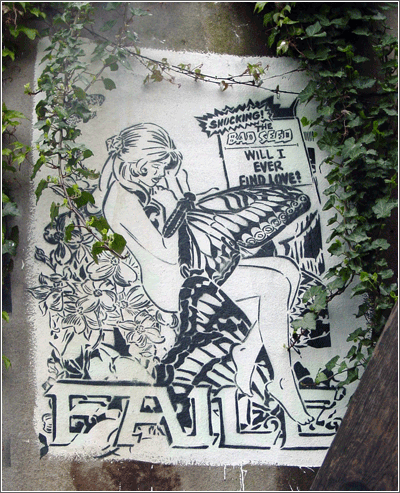
But maybe this train of thought is all focused in the wrong direction. What if it’s not just for style, but to really express oneself, even if it is with one sticker? Not everybody can dedicate their time and work all to art, but they have now learned through seeing street art in action that they, too, can have a voice and a free platform to participate. In the end, it’s all good. I want our streets back, and I open my arms to whomever, even though I might think your shit is wack.
One thing about street art is that its images have entered popular consciousness and have become pretty market-friendly. I recently talked to the street artist Abe Lincoln Jr., who pointed out that street art has roots not only in graffiti, but also in the wheat-paste posters and stickers of punk and skateboarding culture. We’ve seen what has happened with these cultures as commercial interests take hold. Still, artists have to make a living. How are you balancing this? Can artists really separate the art that’s in the street from the art that’s on a coffee mug?
Dan Witz: I’ve never had much luck making a living from my street art. Usually I just about break even. I have to admit I still have a deep-seated prejudice that if I did hit the cash and prizes, the quality of the work would suffer. But that’s me. Early on, in my formative art school/noise band years, the rebellion du jour was punk, a kind of knee-jerk/fuck-off/no-sell-out programming that’s been a hard mindset for me to break out of. Back then, aggressively merchandising something like your nihilist noise band or your high-risk street art was considered suspect. Commercial success was by definition compromising and signaled a lack of integrity. With my easel paintings, it’s always been clear; they’re products, they come from the heart and if I’m lucky they’re gonna be sold to rich people. No conflict. It pays for my street stuff.
This is what I think: Making a living off your art’s about the coolest thing a person can do. These days I’m totally at ease with the idea of artists making good street art and merchandising it or whatever and making a living off of it. If art is a mirror to ourselves, our society, and the artists who market themselves successfully are the ones who survive and are the most influential, then that seems like a pretty honest reflection of our times—of what we value.
The idea of seeing a bunch of gidgets and gadgets with my images on them makes me want to throw up and die.
Let’s face it: The history of art, the canon of great artists, isn’t about the very best artists, it’s about the ones who were best at surviving. For better or worse, it’s the ones who make the great work AND who get it out there AND who can survive success AND can still make original work…etc., these are the artists that make it into the popular consciousness. The incredible and lovely thing about the internet revolution is that it makes networking so much easier, so much more about the quality of the work than the quality of your connections.
M. De Feo: I haven’t made a living off my street art either, even with the wonderful street projects I’ve been blessed with. It doesn’t make a scratch in the money I’ve spent producing them. I never started doing street art to make money, so I couldn’t care less about this imbalance. All things come and go as fads in the eyes of the image-hungry public, and if I have to change my direction as an artist to follow a fad, I’ve failed as an artist. I do what I want to do and if the public likes it, that’s a bonus. Some people confuse selling work with “selling out.” We all have choices and we all interpret them differently. As an artist I have a responsibility to be true to myself and to my work. I support my family and myself by working as a high school art teacher, and I’m lucky to do so. Sharing my passion for the arts with kids is challenging and rewarding. As with my art, I have to keep reinventing myself to look, to find and to share.
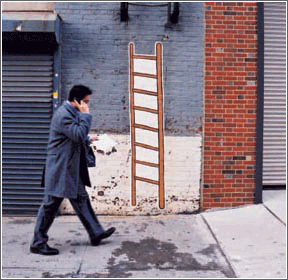
Swoon: Ah, art that’s on the coffee mug. I am of two minds about all of this, at least two. On the one hand, the idea of seeing a bunch of gidgets and gadgets with my images on them makes me want to throw up and die. It’s not just the kitschy reduction of something that I never intended to be on a coffee mug. It’s that when I see these kinds of things my mind does all of these flips thinking about a culture that sees fit to pour all planetary resources into the endless production of shit that we don’t need, shit that probably exploited a labor force and an economy to be created for this brief stop over on the way to the garbage. This kind of marketing has the stink of rampant consumer culture to me, and I don’t like it.
On the other hand, a couple of years back some close friends of mine were making an album and putting it out themselves, and I offered to make the first 300 album covers by hand. I did this because I loved the way that they were trying to make the punk, do-it-yourself ethic come alive in another musical genre, and I thought that it would be nice if people got a chance to buy a handmade piece of artwork for $8 and it also happened to have a record inside it. There is a tendency in a lot of the art world (I know this because I have the tendency myself) to only make things that are big and precious and expensive. Sometimes I want to see art climb down from its high horse and make itself a part of the small things that ordinary people can have and live with. T-shirts and throw pillows and tchotchkes become a part of people’s everyday lives. While I generally resist letting my work get reprinted in such forms, I sometimes envy the populist versatility that these objects embody. As for making a living, it’s been rough forgoing the commercial route, but there have been a few people who have stepped up and really tried hard to support me because they feel a sense of connection to the work I make on the street. This support has been invaluable.
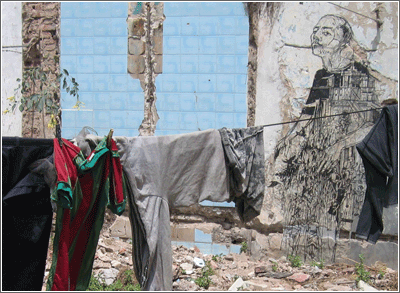
Patrick of Faile: I don’t think it diminishes our work any if we apply it to products that we enjoy, whether it is a coffee cup or a shoe. At least with art on a coffee cup the viewer can enjoy the art and use it for something more useful than something to hang on a wall. Faile’s background is in design, and there are projects that come our way to which we find it challenging or exciting to apply our images. We are not just about the fine art end of things; we also enjoy the challenges that come with solving design issues.
Another thing that we enjoy is being able to wear our own gear. It is very satisfying to be able to wear a bag or shoes that you have designed. I would rather rock our brand than someone else’s brand that I know nothing about. It is nice to know what is behind the products we use, and through our collaborations we get an inside look of what is behind the products we work on. We always take into consideration who we are collaborating with and which product we want to work on. We don’t take on every project that comes our way. We are very selective about the products and the brands we choose to work with. It is important for artists to make up their own minds regarding putting their art on products and choosing the companies they want to work with. Depending how you work it out, it can be very beneficial in terms of challenging yourself and getting your work out to a wider audience. It is also great to have products you designed and to be able to give them to your friends. In the end, the artists need to take into consideration what they want to identify their art with. It’s a personal choice to be made by the artist with no right or wrong answer.
Lastly, where do you think street art is heading? Not that I expect anyone to have a crystal ball, but how might you imagine your own work in 10 years or more?
M. De Feo: Hopefully street art will topple the structures of image consumption, and public space and its unfortunate parallel with advertising, or at least continue to make people smile. For me, it’s only a small piece of a much larger way to express myself. Perhaps to get people reawakened we need to find new terrain, new ways to interrupt things. I like how Vik Muniz once used skywriters to draw clouds and how Andy Goldsworthy plays around with nature (especially his mid-summer snowballs in London). As for my own work in 10 years? Hopefully that’s going to continually evolve, mature, and challenge me, and, most of all, be tons of fun.
Wooster Collective: We try not to get too caught up with trying to figure out where the street-art scene is heading. We enjoy what we do each and day and that’s enough for us. There’s always new offshoots and new artists and that’s what makes it all very exciting. You really don’t know what to expect next. It’s all about discovery, so I guess we’ll just have to wait and see and discover it alongside everyone else.
Dan Witz: If you’d asked me 10 years ago if I thought I’d still be doing street art, I would have answered, “Probably not.” For most of the artists I started out with—Basquiat, Haring, et al—street art was a rebellious phase they went through on their way to other things, which, honestly, was how I assumed I’d progress. I mean, it’s a pretty standard career transition. It’s not just that graffiti and street art are traditionally a younger person’s game, but also it’s hard work. It’s dangerous, and one needs to maintain a kind of precarious punk optimism to keep going back out there year after year. If it’s not the cops or other bad guys chasing you, there’s the dirt and squalor. If the low to no compensation doesn’t bother you, then there’s always the sad reality that your work is so damned vulnerable—that it’s so instantly perishable.
But I keep going back out there for a lot of reasons, but mostly because I love it (especially the squalor). The point, though, is that 10 years ago I would have been wrong about assuming that I’d have quit. So I’m not even going to try and answer about 10 years from now.
Swoon: I am with Dan. I was just going to do one little poster series and that was going to be it. Already, this fixation with street art has led me down various avenues—from experiments with pirate radio to exploring subway tunnels to throwing street parties—all of which are connected in my mind by this invisible thread that I began to pull the day I decided to make something so immaterial as to physically become part of the collage of a city wall. This initial action led me to think about participating visually and socially in the creation of the city in ways I never would have had the chutzpah to imagine before, and so I think there must be other people out there having this same experience.
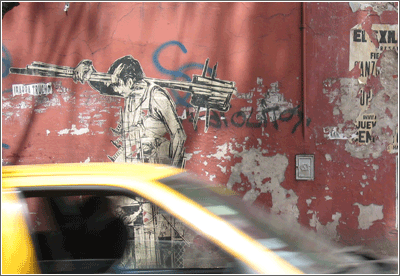
The question that interests me most is not necessarily how the practice of making art on the street will grow and change, because we know it will, in its own cyclical way, but I am curious to find out how the experience of seeing that you can shape the environment you live in with your own two hands will affect the psychology of the city. The process begins with the people who make it, but it doesn’t end there at all. Street art is one of the strongest currents I see acting against the passive spectator culture that suffocates the imagination. Maybe our thought-marked walls are dirty and disorganized in contrast to the pleasingly predictable red and yellow of a McDonald’s façade, but the latter can feel terribly alienating to me, while the other feels like home. I want to see how we can expand upon the lessons we learn from taking to the streets to in order to make them the kind of streets we want to see. As for my work in 10 years, I hope to be making things I do not yet even have the ability to imagine right now.
Patrick of Faile: I think Dan and Swoon hit the nail on the head on this one. I don’t know where street art will go, but I am sure that it will run its course and that people will continue to do it out of love and inspire new people to get involved. Of course, there will be those who’ll move on to other things. For us, street art is done for love of the game, so to say. Once you have it in your blood, it is hard to stop, because your eye learns to see things on the street that urge you to create. It’s hard to stop that urge.
However, being arrested and chased down like a criminal does tend to wear one down a bit. As Dan had mentioned, this has not made us stop. There is just too much to love about working on the streets to let it go all together. I think we will always have the urge to add a little love here and there. I have no clue what will happen to street art down the road, and that it something that I don’t worry about to much. Street art has room to grow and over time. I am sure it will be absorbed into mainstream culture far beyond what it is today, like everything usually is over time. I hope in 10 years Faile will still be making art, designing things, and coming up with crazy unexpected ideas. As long as we can do what we love and can make a living from it, it’s all good in the ’hood. Much love, all.


